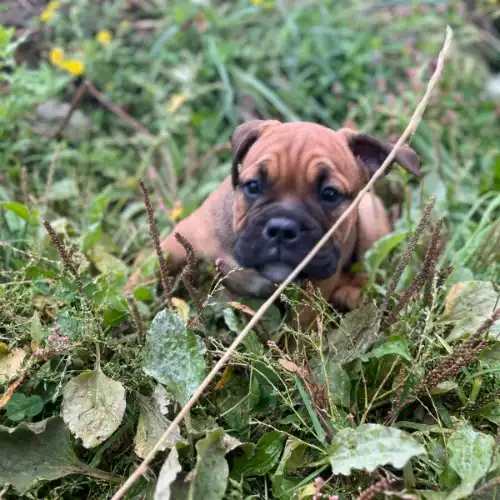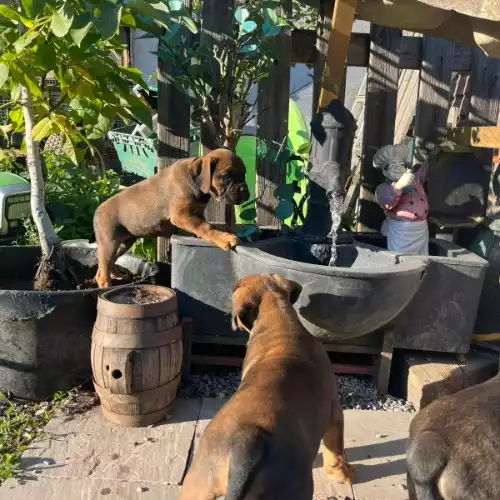The Olde English Bulldogge
A devoted, brave, and loving breed, the Olde English Bulldogge is renowned for striking a balance between sweetness and strength. Olde English Bulldogges have a strong sense of familial loyalty. They love being near their people. They are also renowned for developing deep relationships and are frequently referred to as "gentle giants" due to their affectionate disposition.
The Olde English Bulldogge is a unique and well-balanced breed that was created to be healthier, more athletic, and more even-tempered while maintaining the traditional appearance of early bulldogs.
To lessen many of the health problems that contemporary English Bulldogs face, the Olde English Bulldogge was carefully bred. They still have certain unique health issues, though, that prospective owners should be aware of, just like any other breed.
The average lifespan of an older English Bulldog is 9 to 14 years; however, with proper breeding and care, they can easily outlive more conventional bulldog breeds. Although the Olde English Bulldogge has minimal nutritional needs, a healthy diet is crucial for preserving its muscular physique, promoting joint health, and preventing issues such as obesity and allergies.
Regular care is still necessary to maintain the Olde English Bulldogge clean, happy, and healthy, even though they are a low-maintenance breed. To make them feel at ease, grooming routines should be established early on. During grooming sessions, only positive reinforcement—such as praise or treats—should be used. Regular grooming is an excellent opportunity to look for parasites, lumps, or skin problems.
Olde English Bulldogge Characteristics
They have a broad stance, a deep chest, and are compact and sturdy. They are also strong, muscular, and athletic. Old English Bulldoggs weigh between 50 and 80 pounds (22 and 36 kg) and are 16 to 20 inches (40 and 50 cm) tall.
The large, square head of an old English Bulldogge has a prominent jaw. Compared to typical Bulldogs, their muzzle is shorter but not excessively flat, which facilitates better ventilation. Medium-sized, wide-set eyes that are frequently expressive and soulful. The tail is natural and carried low (not docked), and the ears are button-style or rose-shaped. The coat of an Old English Bulldogge is short, shiny, and smooth. Brindle, white, fawn, crimson, and black (solid or mixed) are some of their different colours.
Olde English Bulldogge Health Considerations
Olde English Bulldogs are healthier than English Bulldogs. The Olde English Bulldogges development aimed to make it more robust overall, less brachycephalic (flat-faced), and more athletic. Compared to conventional Bulldogs, they usually experience fewer respiratory, joint, and skin issues as a result.
Breathing problems in older English Bulldogges (Brachycephalic Syndrome) are common health issues to watch for. While not as severe as English Bulldogs, some may nonetheless have short muzzles and exhibit snoring or heat sensitivity. Avoiding strenuous exertion in hot temperatures and making sure there is enough ventilation are key ways to prevent it. Additionally, they may develop elbow and hip dysplasia, a genetic joint disorder in which bones do not fit correctly, sometimes leading to arthritis or pain. Maintaining a healthy weight, giving them moderate exercise, and sourcing from reliable breeders who check for joint problems are ways to prevent this.
Cherry eye, a disorder in which the gland of the third eyelid protrudes, can occur in older English Bulldogs. If it persists, little surgery may be necessary. Because facial wrinkles can retain moisture and germs, they are more likely to get skin fold infections. Frequent fold cleaning aids in avoiding infection and discomfort.
Although congenital heart problems are less common in Olde English Bulldogges, some may be at risk. For early detection, routine veterinary examinations are crucial. Also, some Olde English Bulldogges may have misalignment or overcrowding because of their jaw anatomy; therefore, maintaining good tooth health is crucial. Brushing and dental chews are advised.
Ilnesses in Olde English Bulldogs can be prevented by regular veterinary checkups for vaccinations, parasite control, and early detection; a balanced diet; moderate, regular exercise that keeps weight under control but avoids joint stress; basic grooming; and firstly from purchasing the dog from a reputable breeder who make sure that hip, elbow, and eye health screening been done.
Olde English Bulldogge Diet
High-quality protein meals are essential for the maintenance of an Olde English Bulldogge's muscular body. It's important to seek actual meat as the primary ingredient in commercial foods, such as chicken, cattle, lamb, turkey, or fish. Adult dogs should have between 22 and 28 percent protein. Nutrient balance, including a good ratio of fibre, carbs, fats, vitamins, and minerals, is crucial in the Olde English Bulldogge's diet. 8–15% of fats promote energy and coat health. Omega-3 and omega-6 fatty acids are also important for supporting the skin and joints. To make sure their diet is balanced and to find out if they need any supplements, speak with a veterinarian or canine nutritionist.
Avoiding poor ingredients and fillers is important, and it is necessary to avoid dog food that contains a lot of maize, wheat, soy, byproducts, and artificial additives. For many Olde English Bulldogges, these may result in allergies, bloating, or sensitivities. Bulldogs are prone to dehydration, particularly during the warmer months, so make sure they have access to clean, fresh water at all times.
Depending on age, weight objectives, and activity level, portion controls are necessary. Keep an eye out for weight gain, particularly if the Olde English Bulldogge isn't as active. To prevent weight gain, use snacks in moderation and use natural, low-fat options such as dental chews or freeze-dried meats.
Olde English Bulldogge Grooming Needs
Due to their short, silky, and form-fitting coats, Old English Bulldogges have moderate shedding throughout the year. It is needed once or twice a week to disperse natural oils, minimise shedding, and remove stray hair with a soft-bristle brush or rubber grooming glove. Bathing should be done every four to six weeks or as needed, but to prevent skin irritation, use a moderate dog shampoo.
Because certain Olde English Bulldogs have facial folds that can retain moisture and debris, it is necessary to clean wrinkles with a soft cloth or pet-safe wipe two to three times a week (or daily if necessary). After cleaning, the dog must be completely dried to avoid irritation or infection.
Every two to four weeks, nails should be trimmed to avoid irritation or overgrowth. It is important to routinely examine their paws for discomfort, dirt, or cracks. If pads are dry or cracked, a dog-safe paw balm can be applied to moisturise them. Every week, the ears of an Olde English Bulldogge should be examined for signs of illness, wax accumulation, or odour. If necessary, use a veterinarian-approved ear cleaner to clean your ears, and stay away from cotton buds.
They should have their teeth washed at least two or three times a week (daily is best) using a soft toothbrush and toothpaste made especially for dogs. Additionally, dental toys and chews might help lower plaque.


